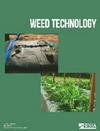Herbicide effects on dormant and post-dormant hybrid bermudagrass putting green turf
IF 1.7
3区 农林科学
Q3 AGRONOMY
引用次数: 0
Abstract
Abstract Herbicide resistance coupled with a dearth of selective herbicide options has increased complexity of annual bluegrass control in hybrid bermudagrass putting greens. Cumyluron, endothall, and methiozolin are herbicides that have controlled annual bluegrass by inhibiting sites of action that are novel compared to herbicides currently used for turfgrass management in the US. However, peer-reviewed literature has no information on hybrid bermudagrass putting green tolerance to these herbicides. Sixteen field studies were established on eight golf greens in Midlothian, VA, in 2021 and 2022 to evaluate effects of cumyluron, endothall, methiozolin, pronamide and trifloxysulfuron on bermudagrass spring transition. The 16 studies were split equally between initiation during full dormancy versus mid-spring transition. Methiozolin applied at 500 and 1000 g ai ha -1 typically increased the heat units (growing degree days with a base temperature of 15 C) required for hybrid bermudagrass to visibly achieve 90% green coverage (T 90 ) when applied to fully dormant hybrid bermudagrass. This delay in green coverage was more pronounced at sites where hybrid bermudagrass vigor was seemingly reduced via abiotic stressors. Endothall was generally more injurious than all other treatments when applied to hybrid bermudagrass during mid-transition. Endothall applied at 840 g ai ha -1 injured hybrid bermudagrass for 0 to 9 d over a threshold of 30% (DOT 30 ), depending on location. In two site-years characterized by increased abiotic stress, methiozolin applied at 1000 g ai ha -1 caused 44 DOT 30 . Cumyluron never injured hybrid bermudagrass over 30% or delayed T 90 regardless of application timing. These results indicate methiozolin should only be applied within labeled rates to actively growing hybrid bermudagrass putting greens, cumyluron can be safely applied at 6450 g ai ha -1 on dormant or actively growing bermudagrass greens, and endothall applications should be limited to dormant bermudagrass greens unless transient phytotoxicity is acceptable.除草剂对休眠和休眠后杂交百慕草铺绿草坪的影响
除草剂抗性加上选择性除草剂选择的缺乏增加了杂交百慕大草推杆果岭蓝草年度控制的复杂性。Cumyluron, endothall和methiozolin是通过抑制作用位点来控制一年生蓝草的除草剂,与目前在美国用于草坪草管理的除草剂相比,这些除草剂是新颖的。然而,同行评议的文献没有关于杂交百慕草对这些除草剂产生绿色耐受性的信息。本研究于2021年和2022年在弗吉尼亚州Midlothian的8个高尔夫球场进行了16项田间研究,评价了cumyluron、endothall、methiozolin、pronamide和trifloxy磺隆对百慕大草春季过渡的影响。这16项研究在完全休眠和春季中期过渡期间平均分配。当施用于完全休眠的杂交百慕大草时,施用500和1000 g / ha -1的甲硫唑啉通常会增加所需的热量单位(基础温度为15℃的生长度日),以明显达到90%的绿色覆盖(t90)。这种绿色覆盖的延迟在杂交百慕大草活力似乎因非生物胁迫而减少的地点更为明显。在杂交百慕草过渡中期施用恩度唑的危害大于其他所有处理。根据不同的位置,施用840 g / h的Endothall,在30%的阈值(DOT 30)下,持续0至9 d。在以非生物胁迫增加为特征的两个站点年中,施用1000 g / ha -1的甲氧唑啉导致44 DOT 30。无论施用时间如何,Cumyluron对杂交百慕草的伤害均未超过30%或延迟T 90。综上所述,甲氧唑啉只能在标记的剂量范围内施用于活跃生长的杂交百慕草果岭,cumyluron在休眠或活跃生长的百慕草果岭上施用6450 g / ha -1是安全的,除非可以接受短暂的植物毒性,否则应限制在休眠的百慕草果岭上施用。
本文章由计算机程序翻译,如有差异,请以英文原文为准。
求助全文
约1分钟内获得全文
求助全文
来源期刊

Weed Technology
农林科学-农艺学
CiteScore
2.90
自引率
21.40%
发文量
89
审稿时长
12-24 weeks
期刊介绍:
Weed Technology publishes original research and scholarship in the form of peer-reviewed articles focused on understanding how weeds are managed.
The journal focuses on:
- Applied aspects concerning the management of weeds in agricultural systems
- Herbicides used to manage undesired vegetation, weed biology and control
- Weed/crop management systems
- Reports of new weed problems
-New technologies for weed management and special articles emphasizing technology transfer to improve weed control
-Articles dealing with plant growth regulators and management of undesired plant growth may also be accepted, provided there is clear relevance to weed science technology, e.g., turfgrass or woody plant management along rights-of-way, vegetation management in forest, aquatic, or other non-crop situations.
-Surveys, education, and extension topics related to weeds will also be considered
 求助内容:
求助内容: 应助结果提醒方式:
应助结果提醒方式:


